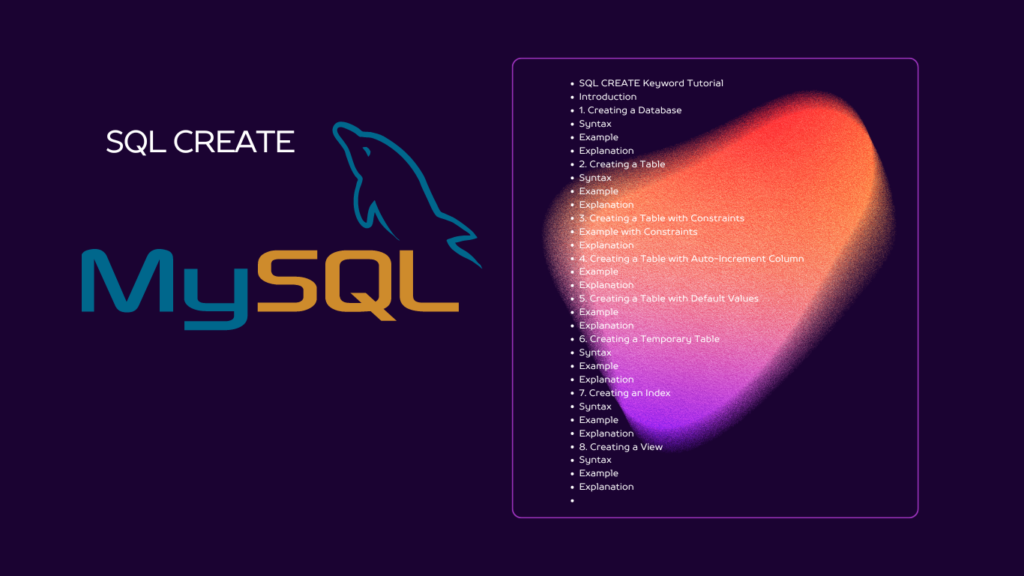SQL CREATE Keyword Tutorial
Introduction
SQL (Structured Query Language) is used to manage and manipulate relational databases. One of the primary keywords used in SQL is CREATE, which is used to create various database objects such as databases, tables, indexes, views, and more. This tutorial will focus on the CREATE keyword, particularly on creating databases and tables.

Table of Contents
1. Creating a Database
Syntax
CREATE DATABASE database_name;Example
CREATE DATABASE SchoolDB;Explanation
CREATE DATABASE: The command to create a new database.SchoolDB: The name of the database being created.
When this command is executed, a new database named SchoolDB is created in the DBMS. You can verify the creation by listing all databases, usually with a command like SHOW DATABASES; in MySQL.
2. Creating a Table
Syntax
CREATE TABLE table_name (
column1 datatype constraints,
column2 datatype constraints,
...
columnN datatype constraints
);Example
CREATE TABLE Students (
StudentID INT PRIMARY KEY,
FirstName VARCHAR(50),
LastName VARCHAR(50),
BirthDate DATE,
EnrollmentDate DATE
);Explanation
CREATE TABLE: The command to create a new table.Students: The name of the table being created.- Columns:
StudentID: An integer column, serves as the primary key.FirstNameandLastName: Variable character columns with a maximum length of 50 characters.BirthDateandEnrollmentDate: Date columns for storing date values.
This command creates a Students table with the specified columns and constraints.
3. Creating a Table with Constraints
Example with Constraints
CREATE TABLE Courses (
CourseID INT PRIMARY KEY,
CourseName VARCHAR(100) NOT NULL,
Credits INT CHECK (Credits > 0),
DepartmentID INT,
FOREIGN KEY (DepartmentID) REFERENCES Departments(DepartmentID)
);Explanation
CourseID: Primary key.CourseName: Must not be null (NOT NULL constraint).Credits: Must be a positive integer (CHECK constraint).DepartmentID: Foreign key referencing theDepartmentstable.
4. Creating a Table with Auto-Increment Column
Example
CREATE TABLE Teachers (
TeacherID INT PRIMARY KEY AUTO_INCREMENT,
FirstName VARCHAR(50),
LastName VARCHAR(50)
);Explanation
AUTO_INCREMENT: Automatically increments theTeacherIDfor each new record inserted.
5. Creating a Table with Default Values
Example
CREATE TABLE Enrollment (
EnrollmentID INT PRIMARY KEY,
StudentID INT,
CourseID INT,
EnrollmentDate DATE DEFAULT CURRENT_DATE
);Explanation
EnrollmentDate: Defaults to the current date if no value is provided during insertion.
6. Creating a Temporary Table
Syntax
CREATE TEMPORARY TABLE temp_table_name (
column1 datatype,
column2 datatype,
...
);Example
CREATE TEMPORARY TABLE TempStudents (
StudentID INT,
Name VARCHAR(50)
);Explanation
TEMPORARY: Indicates that the table is temporary and will be deleted when the session ends.
7. Creating an Index
Syntax
CREATE INDEX index_name ON table_name (column_name);Example
CREATE INDEX idx_student_name ON Students (LastName);Explanation
CREATE INDEX: The command to create an index.idx_student_name: The name of the index.Students: The table on which the index is created.LastName: The column being indexed.
Indexes improve the speed of data retrieval operations on a table at the cost of additional storage space and potential impact on write performance.
8. Creating a View
Syntax
CREATE VIEW view_name AS
SELECT column1, column2, ...
FROM table_name
WHERE condition;Example
CREATE VIEW StudentNames AS
SELECT FirstName, LastName
FROM Students;Explanation
CREATE VIEW: The command to create a view.StudentNames: The name of the view.SELECTstatement: The query defining the view.
Views are virtual tables that provide a way to present data in a specific format or subset without modifying the actual tables.
Summary
The CREATE keyword in SQL is fundamental for defining the structure of databases and their objects. In this tutorial, we’ve covered how to create databases, tables with various constraints, auto-increment columns, default values, temporary tables, indexes, and views. Each example included the syntax, a sample code snippet, and a detailed explanation to help you understand the use and function of the CREATE keyword in SQL.
Feel free to experiment with these commands in your SQL environment to reinforce your learning and understand the behavior of each scenario.




